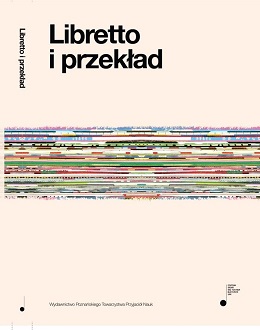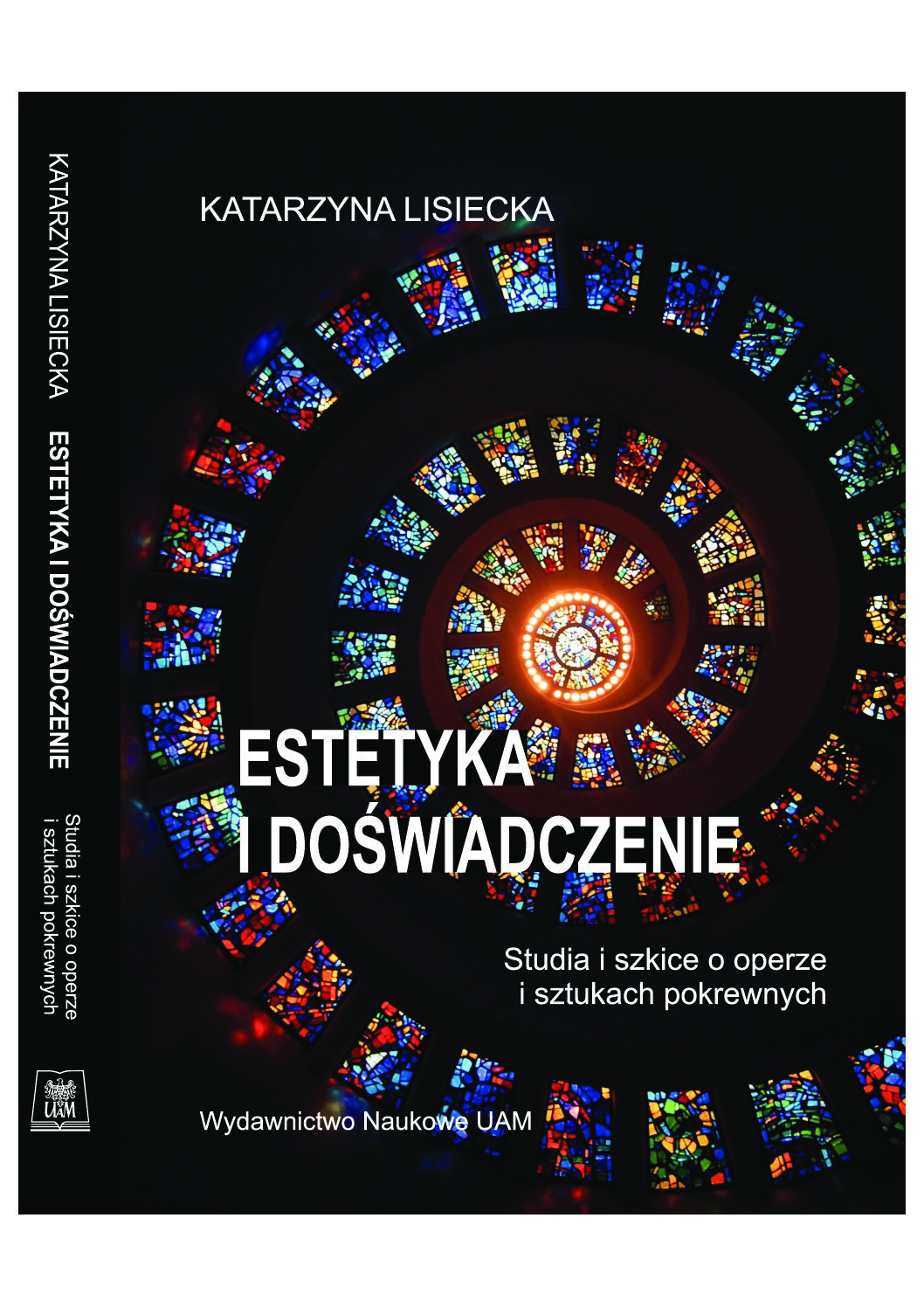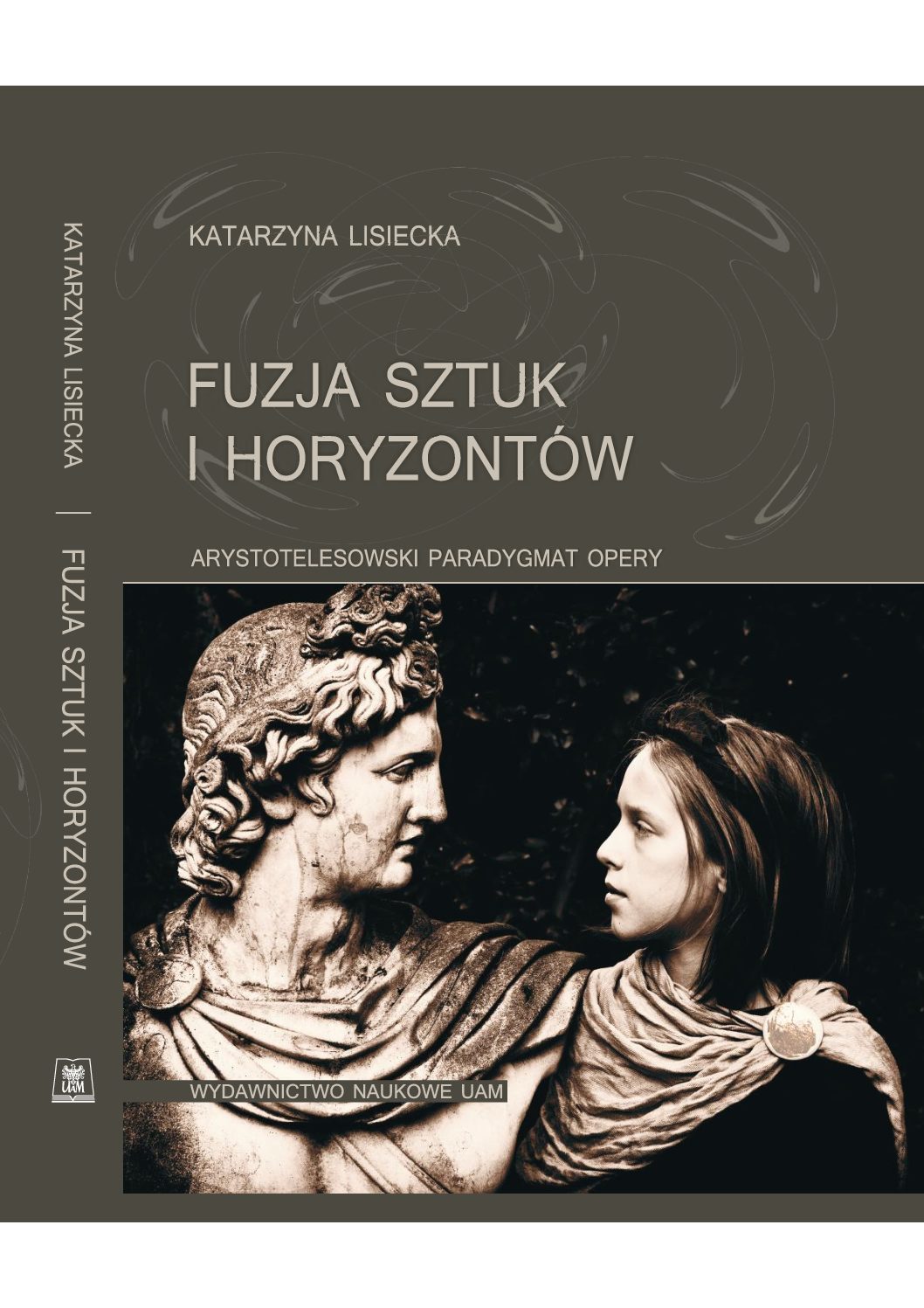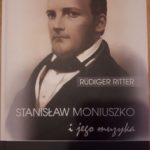14 - 09
2015
Libretto i przekład, pod red. Elżbiety Nowickiej i Aliny Borkowskiej-Rychlewskiej, Poznań: Poznańskie Towarzystwo Przyjaciół Nauk, 2015.
Spis treści
Zamiast wstępu. „Myśl goni myśl, myśl goni myśl…” . O przekładzie libretta rozmawiają Alina Borkowska-Rychlewska i Antoni Libera (s. 5)
O pożytkach z tłumaczenia librett
1. Alina Żórawska-Witkowska, O muzykologicznych pożytkach z badania librett. Kilka refleksji polskiego historyka muzyki (s.25)
2. Michał Bajer, „Ut pictura translatio”. Hipotypoza i opis w pracy Jana Chęcińskiego jako tłumacza włoskich librett (s. 41)
3. Beata Kornatowska, Engelbert Humperdinck – Hänsel und Gretel. Od libretta do przekładu (s. 63)
4. Małgorzata Sokalska, Wielojęzyczność libretta i zaburzenie tożsamości dzieła. Uwagi na marginesie Hagith Karola Szymanowskiego (s. 77)
Wobec problematyki narodowej
5. Swiatłana Niemahaj, Tłumaczenia librett operowych Moniuszki w świetle powrotu do spuścizny dawnego Wielkiego Księstwa Litewskiego (s. 101)
6. Ewa Burzawa-Wessel, Wieland der Schmied Richarda Wagnera i Oscara Schlemma a Kováč Wieland – słowacka opera narodowa Jána Levoslava Belli (s. 119)
7. Anna Komendzińska, Literacko-muzyczny filtr w przekładzie kultury ludowej na przykładach wczesnej polskiej opery narodowej (s. 131)
Praktyka śpiewacza i reżyserska
8. Maciej Straburzyński, Wesele Figara da Pontego, Barańczaka i Rymkiewicza: tłumaczenie jako problem wokalny (s. 151)
9. Elżbieta Sierosławska, Wpływ spółgłosek i samogłosek na wyraz artystyczny frazy tekstowej w przekładach arii operowych (s. 177)
10. Iwona Puchalska, Tłumaczenie libretta jako element reżyserii operowej (s. 187)
Między znakami – między gatunkami
11. Magdalena Bartnikowska, Hanna Winiszewska, Hrabina Caramella czy Duch z bębnem? – o tłumaczeniach tytułów operowych (s. 199)
12. Marta Kmieciak, O przekładzie intersemiotycznym – refleksja nad tekstem, muzyką i scenicznością Salome (Oscar Wilde – Richard Strauss – Jürgen Flimm) (s.213)
13. Joanna Maleszyńska, „Wszyscy jesteśmy aktorami wielkiej opery żebraczej”. O potrzebie przekładu libretta musicalowego (s. 233)
Tłumaczyć – nie tłumaczyć
14. Elżbieta Nowicka, Zarzuela, czyli o nieprzekładalności (s. 249)
15. Ryszard Daniel Golianek, O (nie)możliwości przekładu librett Wagnerowskich: casus Pieśni wiosennej Zygmunta (s. 267)
16. Agnieszka Kosmecka, Przekład niemożliwy – przekład konieczny. O Wozzecku Albana Berga (s. 283)
Alina Żórawska-Witkowska, On the Musicological Adventages of Studying Librettos: Some reflections of a Polish Historian of Music
In the article, the Author indicates the adventages resulting from stutyinf 17th and 18th-century librettos. She makes use of several exemples. In the case of the first opera staged in the Republic of Poland – dramma per musica „Galatea or Gli Amori d’Aci e di Galatea” (libretto by Gabriello Chiabrera – music probably by Sante Orlandi), performed in Warshaw in 1628, the confronataion of the Polish summarization of the composition with two earlier Mantuan editions of the librettos enabled the authors to demonstrate that an extended and very specific version – reffering to the dynasty of the Jagiellons and the Vasas – of the Mantuan work from 1614 nad been performed in Warsaw. On the basis of the analysis of the libretto and its summarization, the author made an attempt to extract the information abaut the musical form of the lost score. The reading of the librettos of two serenata with were composed for the court of August III in Warsaw, led, in turn, to the disclosure of political aspects, previously unknown to historians. „Versi cantati in Varsavia nel celebrarsi per Ordine Reggio in Giorno della Coronazione della Maesta d’Anna Impetatrice delle Russie”, performed in Warsaw in 1736 (libretto by Stefano Benedetto Pallavicini – music by Giovanni Alberto Ristori), showed the unexpectedly large scale of the gratitude of the king for his political protectress tzarina Anna Iovannovna , whereas „La liberalita di Numa Pompilio” (libretto by Giovanni Claudio Pasquini – music by Giovanni Alberto Ristori) performed in Warsaw in 1746, seems to reveal the king’s intention to free Polish peasants for serfdom. The third example discussed in the text, dramma giocoso: „Il Dissoluto punito, o sia Il Don Giovanni” (libretto do Lorenzo da Ponte – music by Wolfgang Amadeus Mozart) help to indicate significant differences which, in comparisonto the Prague original of the composition from 1787, were introduced to its Warsaw’s premiere in 1789, and this despite the fact that half the vocal cast was identical with the original one. Finally, the fourth aspect presented in the text, the difference between the text of the Italian original, in this case, and its translation into Polish, is illustrated on the example of the opera buffa – „La buona figliuola” (libretto by Carlo Goldoni – music by Niccollo Paccinni, Rome 1760) and its adaptation „Czekina, albo Cnotliwa panienka” , written by Wojciech Bogusławski, music by Niccollo Pacinni, Warsaw 1782. The conslusion: when mentioning the places and dates of performances of particular operas, even those bearing the same title, we should always inform which libretto and which score, reflecting the precise form of a particular spectacle, were used in our studies.
Michał Bajer, „Ut pictura translatio”. Hypotyposis and Description in the Work of Jan Chęciński as a Translator of Italian Librettos
The subject of the article is the treatment by Jan Chęciński of linguistic images present in the three librettos of Verdi’s operas which were translated: Rigoletto, La Traviata (Violetta) and Troubadur. In the light of the confucted analysis, translation can be seen as a means of shaping mental representations evoked by hypotyposis and descriptions inherent in the text. The first part demonstrates the basic regularities ruling this process, the second is devoted to to the way of translating a certain form of discourse, which Philippe Hamon defines as a description of operation. The last part concerns the use by the translator of two types of textuzl images: those which function independently from material performances on the stage (imoginatio in absentia) and those which are simultaneous which visual perception (imaginatio in praesentia), Chęciński, following the Italian librettist, detects in the fluent transfer between visual perception and mental image the source of strong, consciously used theatrical effects.
Beata Kornatowska, Engelbert Humperdinck – Hänsel und Gretel. From Libretto to Translation
The article is devoted to the libretto of the opera Hänsel und Gretel by Engelbert Humperdinck and its polish translation, whose author is Roman Kołakowski. It presents the complex origin of the famous opera (from home performance, to singspiel, to a full-scale opera), its literary prototype (the fairy-tale Hansel and Gretel in the Biedermeier style version by Ludwig Bechstein), the features of the libretto by Adelheid Wette, sister of the composer, conntcted with the German bourgeois culture of the end of the 19th century and the earlier elements included in the libretto stemming from the 16th century. As regards the translation, the analysis focuses on deviations from the original and their consequences, which special focus on the dominating subjects of hunger and poverty in the first part of the opera, as well as on the metaphysical sphere, fundamental to the structure and understanding of the work (the protective role of angels, belief in Providence).
Małgorzata Sokalska, Multilingual Librettos and the Distortion of a Work’s Identity. Notes in the Margin of Hagith by Karol Szymanowski
The problem of a multilingual libretto and the specific distortion of the identity of the operatic work connected with it, concerns relatively few compositions. There are chiefly the widely known operas by Christoph W. Gluck (Orpheus and Eurydike, Alcesta) and Giuseppe Verdi (Don Carlos), which were performed in two language versions. A special case of the multilingual character of a libretto, resulting from the translation of the text into a native language, is the Polish opera Hagith by Karol Szymanowski. This composition, potentially (in score) or practically (in the form of recordings and performance practice) exist in three aesthetically equivalent language versions: as a fin-de-siecle German opera in the style of Richard Strauss with German text by Felix Dormann, as a modyfied Young Poland version in the translation by Stanisław Barącz, and finally, as a stylized Biblically contemporized theatrical experiment rewritten by Anna Świrszczyńska.
Swiatłana Niemahaj, Translations of the Operatic Librettos of Moniuszko in the Light of the Return to the Heritage Old Grabd Duchy of Lithuania
A growing awareness of the relationship of the artistic oeuvre of Stanisław Moniuszko with the multifaith and multilingual culture of the Old Grand Duchy of Lithuania has led to the altered reception of his work in the centuries which arose in the place of this, today nonexistent, state. A contemporary interpretation of his heritage as a significant historical ingredient of the culture of the modern Belarus justifies the translation of the rich Polish-language literature of Lithuania – including that from the 19th century – into the Belarusian language. In this respect, the operatic librettos of Moniuszko may be regarded as an element of the adaptation to new linguistic conditions which arose in the territories of the former Grand Duchy of Lithuania. At the stage of the formation of national identity, which Belarus is undergoing today, staging the composer’s operas in the native language fulfils an important function of revival and enlighttenment.
Ewa Burzawa-Wessel, Wieland der Schmied by Richard Wagner and Oscar Schlemm a Kováč Wieland – Slovak National Opera by Ján Levoslav Bella
The dramatic outline of Wieland der Schmied by Richard Wagner was created in 1850. The figure of the blacksmith Wieland symbolizes the ideal of the independent artist, a parabole of the situation of the oppressed people and the life situation of Wagner who, by condensing the saga, completed his The Artwork of the Future. He give up his compositorial plans because he received no commission for writing the opera. 30 years later, an admirer of Wagner’s oeuvre – Oscar Schlemm, embarks upon dramatizing thr outline of Wieland der Schmied. In his work, Schlemm imitates the style and literary language of Wagner’s tetralogy. The drama by Schlemm aroused the interest of Slovak composer Jána Levoslav Bella who transposed the symbolism and the subject of the drama into the Slovak nation, suffering repression from the Hungarian authorities. Bella composed the opera with a German text in the 1880s. As late as in 1926 the opera was staged with a libretto congenially translated by Vladimir Roy.
Anna Komendzińska, The Literary and Musical Filter in the Translation of Folk Culture on the Examples of the Early Polish National Opera
The subjest of the interdisciplinary reflection of the author is the presence of folk material (stories and music) in works of operating art, illustrated by examples from librettos and scores of early Polish national operas. The literary and musical considerations primarily deal with three works: Nędza uszczęśliwiona by Wojciech Bogusławski and Maciej Kamieński, Agatka czyli Przyjazd pana by Maciej Radziwiłł and Johann David Holland and Cud albo Krakowiacy i Górale by Wojciech Bogusławski and Jan Stefani. In the recognition and association of folk motifs, the author also draws upon texts compiled by folkartists. The folk imagery and its artustic adaptation do not allow us to escape its opposite: town – village, homeliness – strangerness, feminine – masculine, and above all – to go beyond the anthropological.9
Maciej Straburzyński, The Marriage of Figaro by da Ponte, Barańczak and Rymkiewicz: Translation as a Vocal Problem
The article is an attempt tounderstand the complex and rarely studied question of the relationship between the translation of an opera’s libretto and broadly understood vocality. The influence of translation upon the vocal-theatrical creation and vocal technique is discussed on the example of two translations of Mozart’s The Marriage of Figaro, prepared by Aleksander Rymkiewicz and Stanisław Barańczak. The analysis is devoted to two parts. The first part presents the scientic complex of translation (the relation of the translation in stage production and the stage construction of operatic characters, in the second, in turn – the vocal context („phonetic” faithfulness, the occurrence of constant clusters, hard and soft attack and articulation). This article is supplemented with the results of a survey conducted among students of the J. I. Paderewski Academy of Music in Poznań, , who in the academic year of 2012/2013 prepared The Marriage of Figaro at the Teatr Wielki in Poznań in the translation by Stanisław Barańczak.
Elżbieta Sierosławska, The Compact of Consonants and Vowels on the Artistic Impact of a Textual Phrase in the Translations of Operatic Arias
The article depicts the role played by consonants and vowels in the creation of the artistic impact of the textual phrasing of operatic arias and their translations. A fundamental issue here is the quality of consonants and connsonat clusters which influence the comprehension or incomprehension of a sung text. The aspects presented in the article comprise, among others, musical signs for characterizing protagonists, the role of voice in translation, and the most important issue: the melodiousness of translation.
Iwona Puchalska, Translation of a Libretto as an Element of Operatic Direction
The subject of the article is reflection upon the place, the role and the way of functioning of the translation of a libretto in modern theatrical practice. Translation of a libretto can made accessible to the audience during a performance in (at least) three ways: as part of the programme, as text displayed during the performance or (last commonly today)- as a sung text. The article attempts to indicate the main benefits in inconveniences typical of each these ways, with special emphasis on displayed text and the forms of its connections with the musical structures od scenes, and also with the director’s concept for the total production.
Magdalena Bartnikowska, Hanna Winiszewska, Hrabia Caramella or A Ghost with a Drum? – on the Translations of the Titles of Operas
A title, as an element of text found in its initial position, constitues not only a metatextual utterance avout the compisition, but also functions as a delimiter of the libretto’s contents. A title fulfils an identifying function, constitues a separate text, by some scholars is even defined as a separate literary genre (H. Levin), but at the same time constitues an integral part of the composition (D. Danek). In the light of the important position of the title in the structure of a literary work, and, consequently, in a libretto, this article suggests to include the onomastic studies in the reflection upon artistic productions. The authors present the strategy for title translation, linguistic phenomena and types of equivalence in translating titles. At the same time, they pay attention to the function of the composition’s titles addressed to an audience from agiven cultural circle. In order of achieve this, they discuss translations of titles, chiefly 18-th century librettos, and indicate the issues common for the translational strategy of various literary genres.
Marta Kmieciak, About Intersemiotic Translation – Reflections on the Text, Music and Scenic Features of Salome (Oscar Wilde – Richard Strauss – Jürgen Flimm)
The text explores the drama by Oscar Wilde and two others compositions, interpretations of it, using the languages of separate system of signs. The interest is focused on the interaction and dialogue between the versions: the literary, the musical and the theatrical. The composition by Richard Strauss is not a faithful transfer of the drama into the musical dimension, thus, apart from musical illustrations of the drama the authors have analyzed the senses superimposed on the text, such as leitmotifs introducing the subconscious thoughts of the protagonists, often ascribing them characterological features of psychological traits different to those in the drama. The theatrical component of Salome directed by Jürgen Flimm refers not only to the score and the libretto by Strauss, but also draws upon the dramatic original, bringing back to life the motifs abandoned by the composer. The director made us of both sources in order to create an original and coherent theatrical picture.
Joanna Maleszyńska, „We were all Actors of the Great Beggar’s Opera”. About the Need to Translate Musical Librettos
The Beggar’s Opera by John Gay and Christopher Pepush from 1728 provides an example of a masterpiece opening a long and rich history of socially and politically involved musicals. Not uniform as far as its genre is concerned, combining the features of an opera nad operetta, vaudeville and singspiel, the composition was classified as ballad opera due to the important role played in it by songs. Satirically commenting on the tragic condition of the contemporary British state, The Beggar’s Opera came to be a source of numerous, artistically successful rewritings, always preserving the basic plot outline and overall ironic tone. Hovever, in the process of translation into national languages, the opera absorbed elements of local characteristics typical of the group of persons being described. The sting od satire in each adaptation of the musical is aimed at dishonest rulers, who – as opposed to petty criminals and robbers – are never held accountable for their roguery. Owing to the translation of sung texts and plot rewritings, successive versions of the English musical gained the features of familiarity and at the same time of originality.
Elżbieta Nowicka, Zarzuela, or Untranslatability
The article is devoted to zarzuela, a musical and theatrical form characteristic of the Spanish culture. Zarzuela was popular especially in the 17th century, and later, in a changed cultural context, in the 19th century. The main question to be posed is about the translatability of the text of zarzuela into other languages, considered in the context of its structural and cultural familiarity connected with vernacular culture. Thus, zarzuela is of interest to the author as an example of the possibilities of translation of a libretto in a very broad cultural context, within which we find generic, stilistic, ethnic, linguistic as well as historical and ideological matrices. Zarzuela, a form hitherto very poorly discussed in the Polish musicological and theatre studies, enables one to observe, among others, the processes of the altering artistic circulations in which it was positioned in the course of its development, from high courtly culture to popular bourgeois culture. At the same time, which can be observed in the plots and scenic ideas, it represented an aestethic and idealistic alliance of „town” and „court”, and so twp co-ordinates of the old theatre, relevant until the 19th century. Zarzuela made use in its structure of allegoric figures, and simultaneously remained a kind of document recording the moment ofcreation and first productions. Zarzuela, characteristically, has been performed, almost without exception, in the Spanish language. It escaped the endeavours typical of various developmental stages of other theatrical-musical forms (opera, operetta, vaudeville, musical), consisting in the translation of texts and adjustment of plots to the realities of the culture of the language into which it was translated.
Ryszard Daniel Golianek, On the (im)possibility of Translation of Wagner’s Librettos: the Instance of Siegmund’s Spring Song
Idiomatic texts of the librettos for the musical dramas by Richard Wagner seem to be so tightly linked with the intonation and sound of the German language that all attempts of translating them into other languages represent an impossible task. But because translations of Wagner’s librettos have appeared in historical performance, it is worth looking at them and estimating their value. The author of the article makes an evaluation of translation into Polish of spring song – intended for singing – from the musical drama Walkiria (authors: Teodor Mianowski and Aleksander Bandrowski) and also proposes his own translation version of this song. The discussed translations into Polish are analysed against four criteria of adequante translation of operatic librettos defined in the initial section of the text.
Agnieszka Kosmecka, Translation Impossible – Translation Necesarry. On Wozzeck by Alban Berg
The article tries to resolve the problem of the adequacy of translation of the operatic libretto from the original language into Polish. The object of reflection here is a specual example of an Expressionist opera. The author discusses questions connected with the specific sound organisation of the words of the original language and the possibility of representing them in the Polish language. In the case of a composition located in a precisely defined aestethic convention, as Wozzeck by Alban Bers is, the question about the language of the libretto is connected with the issue of the coherence of an operatic work. It seems that the language, united with atonal musical structure, complements the conventions and deliberateness of the Expressionist composition.







